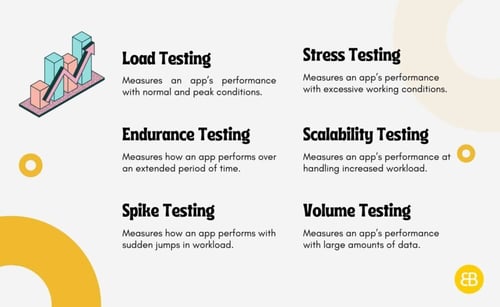Table of Contents
Are you in the process of designing and building a mobile app for your business? If so, it's crucial to understand that launching an app is only half the battle.
Ensuring a great app performance through rigorous testing at each stage of development is critical to delivering an exceptional user experience. An app performance test can help identify any potential issues or glitches before they become stumbling blocks due to user dissatisfaction.
In this article, we'll provide an overview of app performance testing and best practices to ensure successful execution!
What Is App Performance Testing?
Performance testing is a must-have for any application development team to ensure optimal performance at every stage of the development process and reduce rework costs.
For example, app performance can include measuring the number of users that the app can potentially handle, how efficient it is from an operations perspective, and so on. We can determine that using various performance test tools.
Performance testing tools like Sentry help us measure the performance of the application so that we know exactly what's going on in the app from a performance perspective — how quick it was, where the error happened, what piece of code was causing the issue or was causing the crash in the app.
Some tips for reducing performance issues include increasing test coverage, tracking performance testing metrics and trends over multiple release cycles, and setting clear performance objectives.

Types of App Performance Testing
Performance testing is an invaluable strategy used to ensure the quality and robustness of applications. Load, stress, endurance, spike, volume, and scalability tests are each known for measuring performance under a specific set of conditions. We outline the most common types of app performance testing below.
Load Testing
A load test looks at how quickly the app responds under normal and peak conditions to help identify any areas where improvement may be needed before launch or release. Simulating real devices with varying network structures allows developers and product teams to accurately learn how fast the app can load and how to improve loading speed.
Stress Testing
Stress testing puts apps to the ultimate test, pushing them beyond their normal capacity. By simulating an influx of user requests and measuring performance under more strenuous conditions than usual, stress tests can identify potential areas of weakness in an app’s infrastructure so that issues won't arise during peak usage times. This ensures a smooth experience for all users no matter how demanding!
Spike Testing
Spike testing is an effective tool used to evaluate how well your app can manage unexpected but brief bursts of user activity. It helps ensure that the application remains stable and responsive during busy periods, making it easier for users to enjoy a positive experience.
Reliability Testing
This type of test looks at app behaviour in various situations since the performance can be greatly affected by various user settings, networks, and technologies. This type of app performance testing includes security testing, functional testing, regression testing, and even regulatory testing. These tests ensure that the app functions just as designed without any faults or compromises to the user experience.
Getting reliable and accurate results from this kind of comprehensive app performance test will provide us with a better idea of what their users will be seeing when using their app.
Other Types of Testing:
We set up different test scenarios to make sure the app works as expected throughout all stages of development and launch but also post-launch. Creating a test environment enables us to double-check the performance after any bug fixes or new features are added to the app. Here are some more ways you can test app performance:
- Interruption handling testing — looks at how the app handles incoming calls or messages, and even other notifications while being in use.
- Cross-platform compatibility — checks how the app performs on multiple versions of mobile operating systems (e.g., iOS and Android).
- Cross-device compatibility — verifies how the app behaves on various devices (e.g., iPhone 11 versus iPhone 14) by looking at the app on different screen sizes, resolutions, and device settings.

How to Conduct an App Performance Test?
We have a checklist of things that we do to measure performance in general, whether it's a website or a mobile app, We follow that checklist to determine the kind of device that the prospective user will have, what kind of network they will be on, how that user will interact with the app.
Make sure you test on different software and hardware to see if they work together without interference. You’ll also need to be looking into server performance such as data transfer speed and API calls generated from apps. And we can't forget network performance where jitters, packet loss, and latency are tested for optimal speeds.
Many app performance tests require technical knowledge and experience. At EB Pearls, we have professionals with years, even decades, of hands-on experience to handle this level of technical testing, so you can rest assured that you’re app will take off successfully!
How Do We Identify App Performance Issues?
To identify app performance issues, we rely on Quality Assurance (QA) and Quality Control (QC) methods. These processes are similar in that they aim to ensure that the quality of the end product meets our expectations.
QA is a proactive process that focuses on all development cycles, whereas QC is more of a reactive process designed to identify technical issues in the finished app, normally post-launch.
Quality assurance involves user experience testing, integration and automation, code testing, bug prevention, reliability evaluation, and documentation. During QA, the main focus is on choosing robust app architecture, writing good-quality code, and consistently testing the software.
Below you can learn what to do to better identify issues during both the quality assurance and quality control stages:
Test The App In Different Conditions
There are billions of devices operating worldwide, categorised by brand (e.g., iPhone, Samsung), technologies used (e.g., from Wi-Fi5 to Wi-Fi6, or from 4G to 5G), operating systems (e.g., iOS, Android, Windows), etc. In fact, the number of mobile devices operating worldwide was almost 15 billion in 2021, and this number is expected to grow to 18.22 billion by 2025. To ensure your app is working smoothly on each one of these devices, it's critical to perform compatibility testing.
Compare Results To Expectations
To make sure the app performs as expected, we always set up three environments: one is for developers to work on, one is a staging (performance testing) environment, and one is the live (or production) environment. When it comes to the app performance test, we try and understand what's happening in the live and staging environments. As long as the app performs well in a staging environment, we reflect those changes in the live environment.
Make It Scalable Within The Server
Because app performance is quite dependent upon the server side of things, we aim to make everything scalable within the server. So we use this auto-scaling feature from AWS (Amazon Web Services) to ensure that we're always on top of things from a server perspective.
Keep Everything Organised
To make sure we're on the right track, we use prioritisation tools and frameworks, like RICE (Reach, Impact, Confidence, Effort). For instance, this framework enables us to answer questions such as:
- Will solving this problem positively impact a larger part of our audience?
- How much of an impact does this have?
- How confident are we to finish working on it in the timeframe we've set?
- What is the level of effort required to complete this?
Furthermore, all of these elements also tie into a Scrum framework. We use RISE to prioritise bug fixes versus new features and then we look at the bigger picture from a more technical perspective, and include everything into a Scrum framework. This allows us to set realistic deadlines while ensuring we're able to meet the goals we set each week.

Common Causes for App Performance Issues
Mobile performance testing is an essential part of the app development process. Without it, apps can be prone to performance problems that render them unusable or cause processing delays and performance lags.
Common performance issues include slow loading times for the app, high events per second to API calls, memory leaks, battery drainage overuse, and unexpected crashes. Proper performance testing helps identify those kinds of issues before your mobile app is released so that you can create optimised applications for users to enjoy.
Poorly Written Code
This can include things like inefficient code, bad coding practices, and code that is not optimised for the specific platform on which it is running. Poorly written code can lead to many problems, including decreased speed, increased memory usage, and increased battery consumption.
Lack of Optimisation
Lack of optimisation can include things like not using the proper data types, not properly handling data, and not using the best algorithms for the task at hand. Lack of optimisation can lead to decreased speed, increased memory usage, and increased battery consumption.
External Factors
Some things might seem out of your control like a user's device that's corrupted, a slow internet connection, or downtime on one or more servers — all of these elements are linked together.
Think of this as a puzzle! You need to find each piece and combine them to boost your app's performance. Fortunately, you can prepare for most of these external factors by optimising your app accordingly, having backup servers, and improving along the way.
Mobile App Performance Testing: Bottom Line
Developing great mobile applications is a challenging yet rewarding process. To maintain the performance of your apps you need to utilize effective strategies, measure success and user satisfaction, and conduct tests regularly. The importance of security and reliability should never be overlooked either.
Making sure that your mobile app performs well will not only bring users back more often but result in fewer problems down the road as well.
At EB Pearls, we're always here to help — contact our team of experts and get started today!

Tiffany brings creativity, adapts quickly to new tools, and leads atomic design principles to enhance UI/UX efficiency.
Read more Articles by this Author
